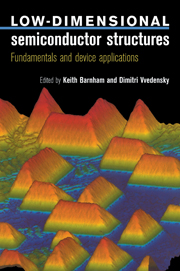Book contents
- Frontmatter
- Contents
- List of contributors
- Preface
- 1 Epitaxial Growth of Semiconductors
- 2 Electrons in Quantum Semiconductor Structures: An Introduction
- 3 Electrons in Quantum Semiconductors Structures: More Advanced Systems and Methods
- 4 Phonons in Low-dimensional Semiconductor Structures
- 5 Localization and Quantum Transport
- 6 Electronic States and Optical Properties of Quantum Wells
- 7 Non-Linear Optics in Low-dimensional Semiconductors
- 8 Semiconductor Lasers
- 9 Mesoscopic Devices
- 10 High-speed Heterostructure Devices
- Solutions to Selected Exercises
- Index
4 - Phonons in Low-dimensional Semiconductor Structures
Published online by Cambridge University Press: 06 July 2010
- Frontmatter
- Contents
- List of contributors
- Preface
- 1 Epitaxial Growth of Semiconductors
- 2 Electrons in Quantum Semiconductor Structures: An Introduction
- 3 Electrons in Quantum Semiconductors Structures: More Advanced Systems and Methods
- 4 Phonons in Low-dimensional Semiconductor Structures
- 5 Localization and Quantum Transport
- 6 Electronic States and Optical Properties of Quantum Wells
- 7 Non-Linear Optics in Low-dimensional Semiconductors
- 8 Semiconductor Lasers
- 9 Mesoscopic Devices
- 10 High-speed Heterostructure Devices
- Solutions to Selected Exercises
- Index
Summary
Introduction
One of the central themes of this book is how reducing the size of semiconductor structures down to mesoscopic and smaller scales brings the quantum wave nature of electrons into play, resulting in electronic and optical properties which are markedly different from those of bulk semiconductors. Chapters 6–10 describe how these properties can be exploited in device applications. But one of the key challenges facing physicists and engineers is how to make devices operate at room temperature. The main obstacle to achieving this goal is the unavoidable presence of phonons, the quantum vibrations of atoms making up a solid, and their ability to scatter electrons.
Phonons would thus appear to occupy an uncomfortable position in the study of low-dimensional structures, with an understanding of their properties required solely for the purpose of finding ways to reduce their interaction with electrons. As we shall see in this chapter, however, the physics of phonons in low-dimensional structures is sufficiently fundamental and non-trivial to be of interest in its own right. Just as for electrons, phonons can be confined within heterostructures and we would like to know how the dynamics of low-dimensional phonons differs from that of bulk phonons. We would also like to understand the effects of dimensionality on the electron–phonon interaction and hence such electron transport properties as the phonon-scattering-limited mobility.
In fact, finding ways to reduce the electron–phonon interaction is not the only reason for investigating phonons in low-dimensional structures.
- Type
- Chapter
- Information
- Low-Dimensional Semiconductor StructuresFundamentals and Device Applications, pp. 123 - 148Publisher: Cambridge University PressPrint publication year: 2001
- 3
- Cited by

